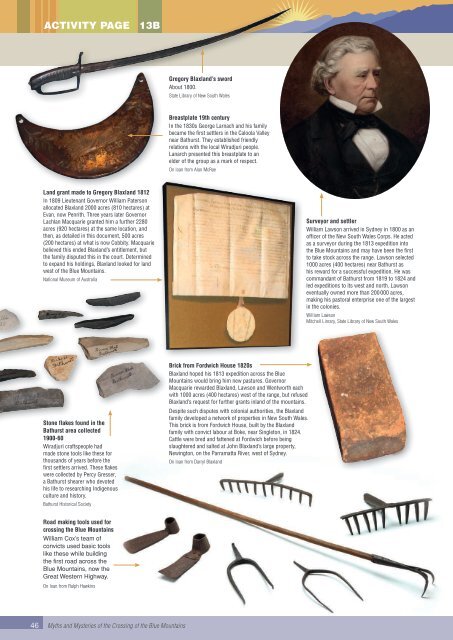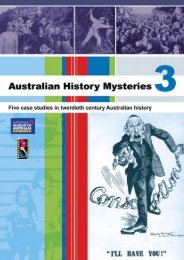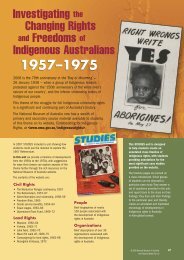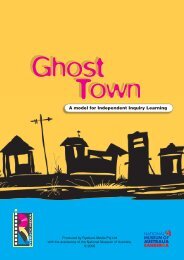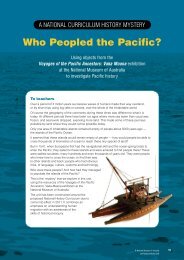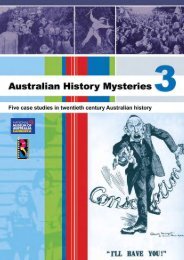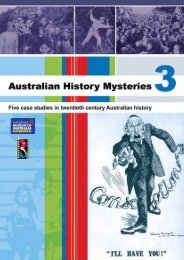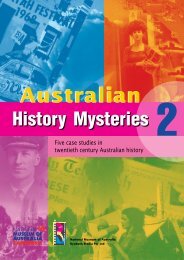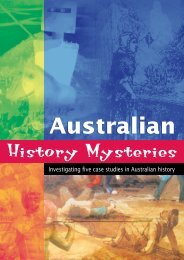Download Teacher Guide & Print Resources - Australian History ...
Download Teacher Guide & Print Resources - Australian History ...
Download Teacher Guide & Print Resources - Australian History ...
Create successful ePaper yourself
Turn your PDF publications into a flip-book with our unique Google optimized e-Paper software.
Activity page<br />
13B<br />
Gregory Blaxland’s sword<br />
About 1800.<br />
State Library of New South Wales<br />
Breastplate 19th century<br />
In the 1830s George Larnach and his family<br />
became the first settlers in the Caloola Valley<br />
near Bathurst. They established friendly<br />
relations with the local Wiradjuri people.<br />
Lanarch presented this breastplate to an<br />
elder of the group as a mark of respect.<br />
On loan from Alan McRae<br />
Land grant made to Gregory Blaxland 1812<br />
In 1809 Lieutenant Governor William Paterson<br />
allocated Blaxland 2000 acres (810 hectares) at<br />
Evan, now Penrith. Three years later Governor<br />
Lachlan Macquarie granted him a further 2280<br />
acres (920 hectares) at the same location, and<br />
then, as detailed in this document, 500 acres<br />
(200 hectares) at what is now Cobbity. Macquarie<br />
believed this ended Blaxland’s entitlement, but<br />
the family disputed this in the court. Determined<br />
to expand his holdings, Blaxland looked for land<br />
west of the Blue Mountains.<br />
National Museum of Australia<br />
Surveyor and settler<br />
William Lawson arrived in Sydney in 1800 as an<br />
officer of the New South Wales Corps. He acted<br />
as a surveyor during the 1813 expedition into<br />
the Blue Mountains and may have been the first<br />
to take stock across the range. Lawson selected<br />
1000 acres (400 hectares) near Bathurst as<br />
his reward for a successful expedition. He was<br />
commandant of Bathurst from 1819 to 1824 and<br />
led expeditions to its west and north. Lawson<br />
eventually owned more than 200 000 acres,<br />
making his pastoral enterprise one of the largest<br />
in the colonies.<br />
William Lawson<br />
Mitchell Linrary, State Library of New South Wales<br />
Stone flakes found in the<br />
Bathurst area collected<br />
1900-60<br />
Wiradjuri craftspeople had<br />
made stone tools like these for<br />
thousands of years before the<br />
first settlers arrived. These flakes<br />
were collected by Percy Gresser,<br />
a Bathurst shearer who devoted<br />
his life to researching Indigenous<br />
culture and history.<br />
Bathurst Historical Society<br />
Brick from Fordwich House 1820s<br />
Blaxland hoped his 1813 expedition across the Blue<br />
Mountains would bring him new pastures. Governor<br />
Macquarie rewarded Blaxland, Lawson and Wentworth each<br />
with 1000 acres (400 hectares) west of the range, but refused<br />
Blaxland’s request for further grants inland of the mountains.<br />
Despite such disputes with colonial authorities, the Blaxland<br />
family developed a network of properties in New South Wales.<br />
This brick is from Fordwich House, built by the Blaxland<br />
family with convict labour at Boke, near Singleton, in 1824.<br />
Cattle were bred and fattened at Fordwich before being<br />
slaughtered and salted at John Blaxland’s large property,<br />
Newington, on the Parramatta River, west of Sydney.<br />
On loan from Darryl Blaxland<br />
Road making tools used for<br />
crossing the Blue Mountains<br />
William Cox’s team of<br />
convicts used basic tools<br />
like these while building<br />
the first road across the<br />
Blue Mountains, now the<br />
Great Western Highway.<br />
On loan from Ralph Hawkins<br />
46<br />
Myths and Mysteries of the Crossing of the Blue Mountains


